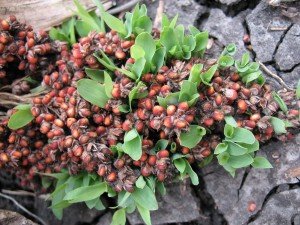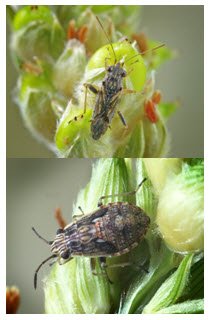Contributors: Susan Maas (CRDC), Lewis Wilson (CSIRO)
There are currently reports of high numbers of Rutherglen bugs (RGB) in cotton across a number of growing regions (Downs, Namoi, Gwydir), and questions being asked about whether this pest can cause damage to reproductive cotton.
This season has seen large spring migrations of RGB into cropping areas from Emerald to the Liverpool Plains. Although the immigrations seem to have slowed now, the populations being seen in cotton may be the result of local movement from weeds or crop hosts (e.g. canola, sunflowers).
Rutherglen bug (Nysius vinitor) is a native species, adults are 3-4 mm long, mottled grey-brown-black, and have clear wings folded flat over the back. Nymphs are wingless, with a reddish-brown, pear-shaped body. Rutherglen bugs breed on a wide range of native and weed hosts, building up to large numbers in inland areas when winter and spring rainfall allows the growth of native herbs and weeds. In spring, as the hosts start to dry off, large numbers of adult bugs will move into the eastern cropping areas, migrating on the winds associated with storm fronts. In summer, these migration events stop, and by mid February females cease producing eggs and populations tend to decline going into autumn.
Better known as a pest of grain crops (sunflowers, sorghum, canola, safflower), RGB is not considered a pest of cotton. RGB damage to seedling cotton, and other crops, has been observed occasionally, particularly under hot, dry conditions. The damage to seedling crops is caused by large numbers of bugs sucking on the small plants, with sustained feeding pressure causing seedlings to wilt and die. This sort of damage can occur in autumn or summer.
Seedling crops at greatest risk are those adjacent to weed hosts, stubbles of canola, sorghum or sunflower, or planted directly into the stubble of these crops (e.g. maize into canola stubble).

Lodged sorghum head sprouting. This fallen seed was supporting a population of Rutherglen bug adults and nymphs.
Nymphs are able to survive for some time on fallen seed and will walk from stubbles, following cultivation or from drying weeds into neighbouring crops. Often damage is confined to the edges of the fields. The movement of RGB nymphs into seedling crops can be managed with border sprays.
Because RGB has not been considered a pest of cotton, there is little known about its capacity to cause damage. Luckily, there is one published study of RGB in cotton in Australia, and a little work in the US on a similar species (False Chinch Bug, Nysius raphanus) which provides some guidance.
The Australian study (Chinajariyawong, Walter and Harris, 1989) showed that neither adults nor nymphs caused any damage to squares (including damage to anthers, ovaries or stamina columns). These studies also found that RGB survival on cotton was quite short and there was no reproduction; cotton is not a good host. Given this information, it is unlikely that populations of RGB will persist in cotton and increase as a result of reproduction (as happens in sunflower and sorghum). The US study showed a similar result, with high numbers of False Chinch Bug causing no reduction in the number of fruit set.
If extremely high bug numbers are found in cotton, monitoring plant growth and fruiting will indicate if there is accumulating crop damage. Look for damage to terminals (wilting, blackening), and cut open fruit to check for blackened stamens in squares and staining of the seeds in young bolls. Monitoring techniques for cotton plant damage can be found in the Cotton Pest Management Guide. Continue to monitor for other causes of reduced retention.
There are no products registered for control of Rutherglen bugs in cotton. While some products in cotton may provide incidental control it is important to consider the impact on beneficials and the likelihood of future impacts, including the inadvertent resistance pressure on aphids, and the risk of flaring other pests such as mites and silverleaf whitefly. Refer to the IRMS and always follow label directions.
As with IPM for all cotton pests and diseases, it is important to have good farm hygiene that includes removal of weeds that the pest may use as hosts. In the case of RGB, particularly mat-like weed growth (e.g. pigweed, sowthistle, capeweed, fleabane and cudweed).

